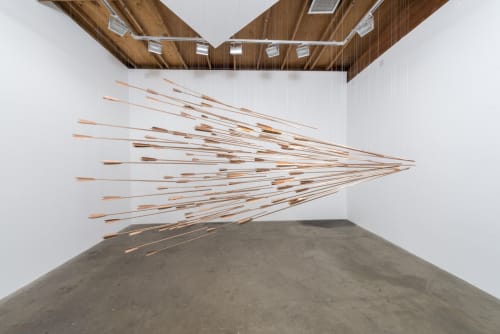A day of dense, low-lying fog finally succumbed to heavy rainfall over the city of Los Angeles. As we danced around the puddles, making our way up La Cienaga Boulevard to Honor Fraser, I paused to look down at the canal (which I later learned is called Ballona Creek, a relatively inconsequential waterway in the grand scheme of the Los Angeles basin). Never had I seen the water level so high; where one usually sees a bare trickle traveling down the concrete channel, there was a swift surging torrent. A storm drain became a veritable cascade, thundering steadily into the creek.
Inside the gallery, a 40-foot long wall composed of pale wax blocks stretched from one end of the room to the other. The blocks, colored a wan chartreuse, nearly translucent, seemed to emanate a kind of ectoplasmic light from within. A blast of chilled air from the gallery’s air conditioner kept at bay the mortal enemy of wax—heat— while it tickled the back of my damp neck. The titular character of this artwork unfortunately did not know the fraught relationship between wax and heat, and flippantly approached the fiery sun without regard to his waxen wings.
At the opening, a small crowd ensconced itself in an adjoining gallery, as other visitors approached and regarded a collection of copper arrows suspended from the ceiling. The arrows all point to an invisible spot, just at eye level, where one enters the room. Standing at the apex, the bright tips of the arrowheads come into sharp focus, while their foreshortened shafts recede abruptly and divergently. It is like looking at an explosion in suspension, like a glance up at the sky in the middle of a hailstorm.
Next came maps. Delicately folded by origami master Robert Lang, isolated ribbons crisscross the front of the paper—yet, when viewed from behind (the maps are framed and suspended from the ceiling, allowing the viewer to approach them sculpturally), one sees a patchwork, an underlying scaffold, revealing the manipulations of the paper. As the paper, so the land: these are all maps purported to lead to the mythical, elusive treasure of El Dorado.
I find myself struggling to describe Glenn Kaino’s exhibition except as a chronological progression of encounters. Each art object seemed eminently discrete from the others, the connections between their conceptual underpinnings indistinct. There was no conversation between the works; they seemed to keep to themselves in their own chambers, laying in wait as a series of encounters, a series of challenges or competitors, like those of an epic poem. Indeed, the title of the exhibition—Labyrinths—encourages this interpretation, recalling the feats and failings of Perseus, Icarus, and other intrepid heroes.
But this is not a dark labyrinth. This is a brightly lit, spacious gallery. Our encounters here occur in the minutiae of perception, rather than through physical exertions.
The final room of the exhibition—or the first room, depending on your course of travel—contains the only grouping of works. At first glance one sees a low wooden platform, a construction made of sandpaper and propped up on two saw horses, and a mirror with black wax affixed to its surface. Thin lines of water trace along the platform, laid out in the pattern of a labyrinth by the application of hydrophobic material over the wood. I glanced up at the ceiling, thinking for a brief moment that the artist was harnessing the elements outside for his labyrinth, but no, the water here is not the kind wetting the sidewalks outside at that moment. These lines were made from tears. Synthetic tears, in fact, which, I learned, had been developed by a scientist to contain the chemical composition found in tears shed while experiencing the feeling of hope. There are angry tears and there are despondent tears, tears of grief, of pain, of joy, the emotions apparently causing slight changes in the water. I wondered—gazing at the mute channels of what appeared to be ordinary water—could you taste the hope on your tongue?
The subtlety of this transparent labyrinth, however, was overpowered by the last piece. A polished mirror-like surface that bears the marks of burning candles; a thin layer of black carbon snaked upwards from a lump of black wax dabbed into the center of the composition. After gazing at the piece for a few seconds, it registers that the wax is—was, rather, before it was burned—in the shape of a map of the United States, turned upside-down. A subtlety vanishes. The viewer is confronted by this very overt symbol, an explicit, political message in the midst of the graceful, subtle beauties that came before it. This dark, almost teenage-angst like expression is a shout among whispers. The exhibition as a whole, as a constellation of otherwise unconnected artworks, suddenly comes into sharp focus. The arrows take on a murderous connotation; the wax wall becomes an admonishment of national hubris.
Reverie is interrupted, the reading of previous works corrupted. And for a moment I feel robbed, as though I was losing something more nuanced, an abstract understanding of the work I had experienced so far. Suddenly a political shade was cast over it all, denying me the delicate, lachrymose labyrinth, the pure Icarus or Perseus.
I was up there, nearing the sun, where I suddenly felt it get hot.
